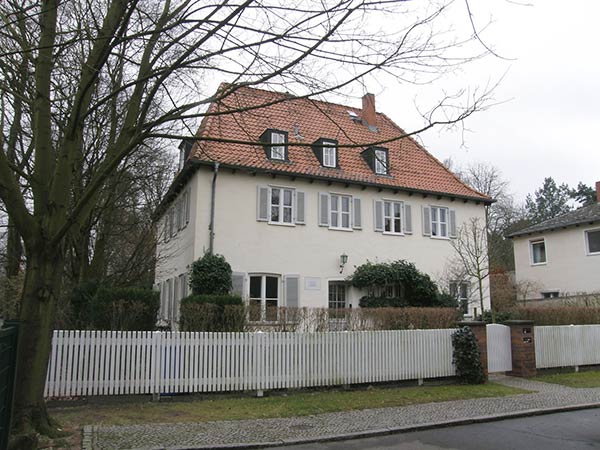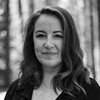Subtotal: $
Checkout
Searching for Home at Bonhoeffer’s Haus
A displaced American seeks direction and discipleship
By Laura M. Fabrycky
March 18, 2020
A haunting image of the destroyed interior of a synagogue is the first image one sees upon entering the conference room in Dietrich Bonhoeffer’s house. It depicts Kristallnacht, or Night of the Broken Glass (November 9–10, 1938), the violent Nazi pogrom unleashed against Jewish citizens and places of worship and businesses across Germany. On the same scrapbook-like panel is a photograph of a roadside crucifix – a large traditional statue of the crucified Jesus – sheltered under a little wooden roof, right next to a sign that reads Juden sind hier nicht erwünscht (Jews not wanted here).
That crisp Saturday morning in November 2016, our family of five took our seats at the conference table among the other visitors to the Bonhoeffer-Haus. I pulled out crayons and paper for our young son. The guide for the tour, Martin, introduced himself as the executive director of the Bonhoeffer-Haus, and then he asked us visitors why we had come, inviting conversation. Each visitor spoke, passing the question like a collection basket at church. When my turn came, I said, diplomatically, as if casually tossing in a coin, “We’re here to learn something about this remarkable man and” – I stopped, searching for the right words, trying to stay casual – “to find inspiration about living faithfully in turbulent times.” My answer masked the dull ache within me, which now came roaring back as I thought back over the past week.
It had been a grueling and disorienting one. Having recently moved to Berlin for my husband’s work at the US embassy, we had welcomed a guest into our new home, our first after unpacking the boxes and hanging the pictures, and then hosted a large gathering at our house a few days later. We had stayed up into the early morning hours watching the US election results come in, and so were underslept. But deeper than all that, we felt as though the ground beneath our feet had shifted, a map we thought we knew now erased. As I feared, the election had proven to be neither a salve to civic wounds nor a valve to release political indignation and anger. Oddly, the winners were defensive and whiny; the losers shocked and morose. Those caught between those strong political poles found the compass in their hands spinning frantically from all the magnetic interference.
Moreover, the pride I often felt about America’s democratic practices was, in that moment, in tatters. Our civic habits of the heart seemed weak, and from afar it seemed the formal liturgies of our political life lacked the capacity to revive them. I ached with homesickness for a world that I had taken for granted and that, perhaps, had never really existed as I had imagined it. Foreign service officers and families are no strangers to political transitions, and we work and live within the context of whomever the American people elect. Explaining America and our democratic processes is part of our diplomatic bread and butter. But as our ambassador at the time regularly noted to German audiences before and after the election, it was proving increasingly difficult to explain what was going on back home in American politics.
Before we had moved to Berlin, I had read a biography about Bonhoeffer, a leader in the Confessing Church that opposed the Nazis, who was executed for a failed plot to assassinate Hitler. I felt that carving out some intentional exploration of our new city, and learning more about this significant figure in history, would do us all good – a curious reprieve from the groans of home.
But when Martin asked us visitors why we had come, I knew that the questions I carried with me into the Bonhoeffer-Haus were bigger, more existential, than just curiosity about this one inspiring man. I wanted maps that could help us navigate our way back home, and I wanted words of reassurance.
Martin then talked to us about Bonhoeffer’s life, telling stories that redirected my attention toward the place where we all now sat. “Dietrich Bonhoeffer did not grow up in this house,” he began. Designed for the family and built in 1935, along with the adjacent property next door, the house was intended to be a place of retirement for Dr. Karl Bonhoeffer and his wife, Paula von Hase Bonhoeffer, so they could enjoy their later years in the company of their large family. They reserved a room for their only unmarried adult son, Dietrich, up on the top floor with dormer windows looking out on the backyard next door, where one of Dietrich’s older sisters lived with her husband and their children. Motioning to the large windows, Martin asked us to imagine a dense forest outside, for the Bonhoeffers’ houses were part of a new development in this section of the Grunewald. Tucked away at the end of this stovepipe road, with a forest beyond, the house, along with its sister-house next door, was “a perfect setting for conspiring,” Martin said – an indication of just how little retiring the Bonhoeffers actually enjoyed there.
Tucked away at the end of this stovepipe road, with a forest beyond, the house was a perfect setting for conspiring.
Our guide walked us through key moments of the Bonhoeffers’ lives, referring to the nine panels of collected family photographs: Dietrich’s happy childhood with his parents and among his brothers and sisters in Breslau and then Berlin; the beginnings of World War I, the loss of his brother Walter in the war, and how his death shattered Paula and affected the entire family; the many places of Dietrich’s education and formation, and the growing power of National Socialism.
When Martin came to that central panel, with the synagogue, the crucifix, and the sign, he drew our focused attention out from the Bonhoeffer family and toward bigger realities, institutions, themes, and patterns of thought in Germany at that time. The family witnessed how rapidly National Socialism worked its way into nearly every aspect of life in Germany, and the church in Germany was not simply a passive victim to this entanglement. Martin said, plainly, that the church failed its neighbors and fellow citizens during the Nazi era, and these juxtaposed photographs depicted that failure: “The story is told that when the church embraced the message that Jews were not welcome – when Jews were told they were not welcome in the household of God – Jesus himself also left the church.” He wanted us to see how the church’s failures were moral, to be sure, but also inextricably theological. In the end, a significant segment of the church embraced the ideology of National Socialism and allowed its theological treasures to be raided and exploited for politically expedient ends. Many believed that the movement’s successes proved that it was God’s will.
Finishing his summary while standing in front of the panel showing Dietrich in the Tegel military prison, recounting his last days before he was put to death on April 9, 1945, at the Flossenbürg concentration camp, Martin invited us to follow him up the two flights of stairs to Dietrich’s bedroom, where the Gestapo took him into custody on April 5, 1943.
The room is spare. A thin rag rug lies on the floor next to a single twin-sized bed. Trim wooden shelves built by Dietrich and his friend Eberhard Bethge ring the room, holding books Dietrich owned and periodicals to which he contributed; although his actual books and journals were donated to a research library long ago, those now at the Bonhoeffer-Haus are identical. Across from the door is the set of windows that overlooks the neighboring house with a clear view of its backyard. His original desk is positioned beneath the windows with a teal-colored desk lamp. “When Bonhoeffer was in this room,” Martin remarked, breaking the group’s hushed silence, “the air was often blue with smoke,” for Dietrich was a heavy cigarette smoker. Martin pointed out a small cigarette burn on the bluish green velvet desk blotter, the singe long gone but a hole remaining.
Here, a giant slept, yet the room is so small and spare, completely human-sized.
Walking into that room did feel magical, but very quickly the imaginative spell dissipated. The room of this hero looked so normal. Here, a giant slept, yet the room is so small and spare, completely human-sized. The desk is human-sized too, the burn mark evidence of human habits and even a touch of carelessness. Everything in the room points to Dietrich Bonhoeffer’s humanity, putting his insights, courage, and self-sacrificing decisions in even sharper relief.
After some time with the group in that bedroom, we descended the stairs, dropped a donation into the metal canister bolted to the entryway wall, and thanked Martin for his hospitality before heading back to our vehicle.
As my husband and i buckled everyone up for the short drive home, the kids started lobbing questions: “Whose house was that again? Why did we go there? Do we have snacks?” I tried to explain in simple language, especially for our two-year-old, who Bonhoeffer was, how he and his family and many of his friends tried to stop “the bad guys,” the Nazis who had come to power in Germany. Simply introducing the word Nazi to their lives was meaty stuff for a young family on a Saturday morning. We rumbled back down the narrow cobblestone road toward home. The roads grew wider and the cobblestones gave way to pavement, and we fell quiet as the rumbling and jostling of the road quieted too. Staring out the window as trees and houses flashed by, I sighed aloud, “That was amazing.” Yet I still felt the exhaustion and questions that I carried with me to Bonhoeffer’s house.
On our way back to ours, we motored past the Grunewald S-Bahn station, with its gingerbread-house styling coupled with a morbid memorial of its own, Gleis 17 (Platform 17). From this station, Nazis transported thousands of Jewish Berliners to concentration camps in their attempt to make Berlin judenfrei, Jew free. At last I said, “I didn’t get my questions answered in the way I wanted to.” My husband nodded silently. Oddly, despite not having gotten what I hoped for, I felt a new hope stirring in me. Hearing Martin tell Dietrich Bonhoeffer’s story in that house fired my imagination about our home. Even though not a single aspect of my life resembled Bonhoeffer’s, the Bonhoeffer-Haus bore witness as a place to human experiences I knew in my daily life. Wordlessly, the Haus disclosed realities, conveyed memories of things I didn’t realize I needed to remember. The house had its own tacit form of communication about the silent truths of human life. I sensed that the spinning compass inside me had regained its orientation, my longing for a lost home eclipsed by a feeling of renewed hope alongside the sensation of exile. I wanted to experience more of the silent witness of that home and hear its stories again. I wanted others to experience it too.

Bonhoeffer’s House. (Public domain)
Already a subscriber? Sign in
Try 3 months of unlimited access. Start your FREE TRIAL today. Cancel anytime.






